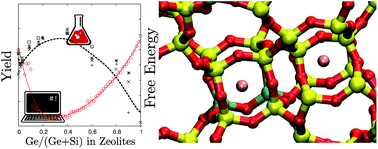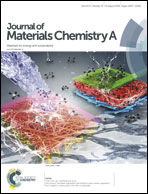The Si–Ge substitutional series in the chiral STW zeolite structure type†
Abstract
The whole compositional range (Gef = Ge/(Ge + Si) = 0 to 1) of zeolite STW has been synthesized and studied by a comprehensive combined experimental–theoretical approach. The yield of the zeolite goes through a maximum and then drops at the GeO2 side of the series, following the inverse of the calculated free energy curve. The unit cell generally expands, roughly linearly, as the Gef increases, but a notable resilience to expansion is observed at the high silica side. This can be attributed to the more rigid character of SiO2 and the ability of Ge units to deform. Density functional theory calculations provide a new assignment of the previously controversial 19F MAS NMR resonances for occluded fluoride, which is based not only on the number of Ge atoms in the double-4-ring units but also on the way they are associated (namely, no Ge, isolated Ge, Ge pairs or closed Ge clusters). While we found an overall good agreement between the experimental and theoretical trends in preferential occupation of different crystallographic sites by Ge, the theoretical models show more sharp and abrupt tendencies, likely due both to limitations of the approach and to kinetic factors that allow metastable configurations to actually exist.



 Please wait while we load your content...
Please wait while we load your content...